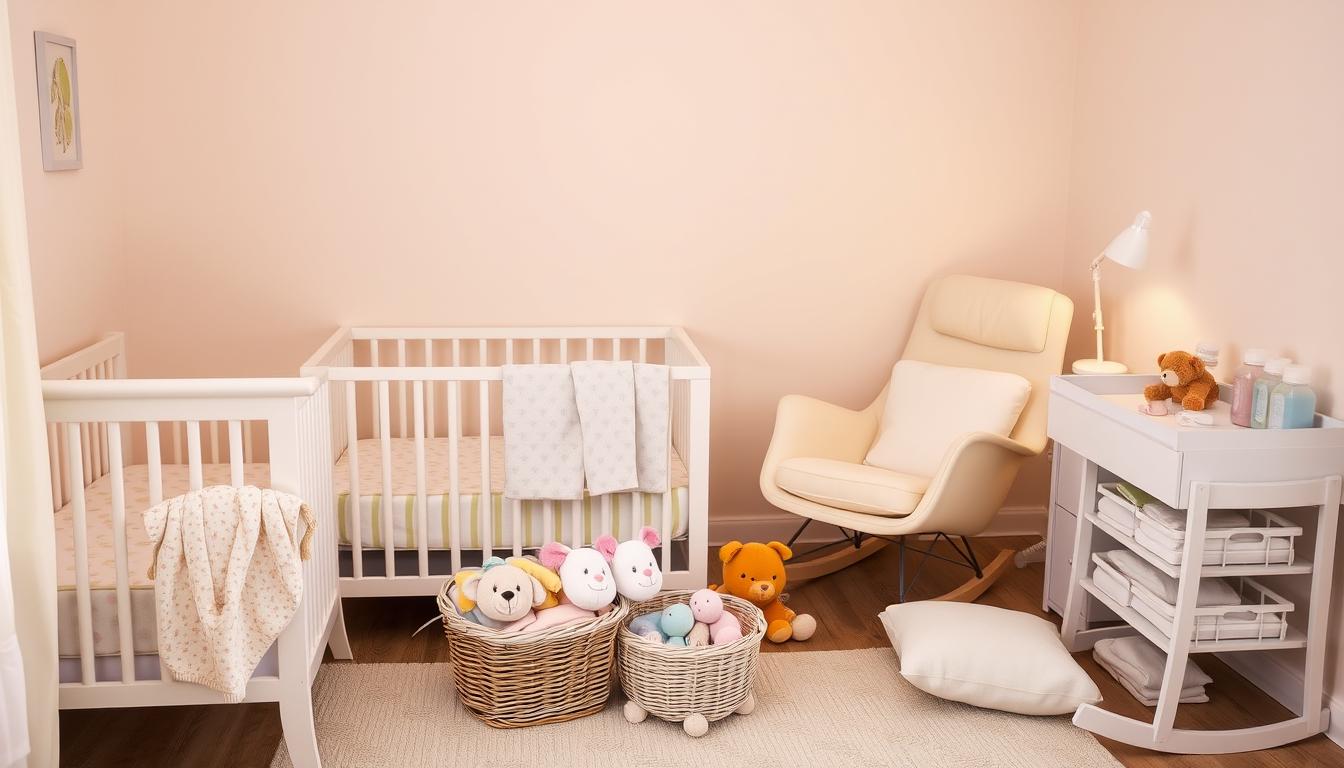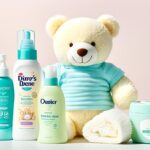What Does a Baby Absolutely Need? Essential Guide. Being a new parent can feel overwhelming. There’s a long list of things your baby needs. This includes diapers, clothes, and items for feeding and sleep. But what are the must-haves for a newborn? Let’s dive into the basics every baby needs for a healthy start.
Table of Contents
ToggleKey Takeaways
- Diapers, clothing, and baby formula are essential for a newborn’s basic care and nourishment.
- Toys, cribs, and strollers promote your baby’s development and make daily life more manageable.
- Car seats, pacifiers, and other baby products ensure your little one’s safety and comfort.
- Budgeting for a baby’s needs is crucial to prepare for the financial responsibilities of parenthood.
- Researching and investing in the right products can make a significant difference in your baby’s well-being.
What does a baby absolutely need?
Welcoming a new baby is both thrilling and challenging for parents. Preparing a safe and loving space for your little one is key. It’s vital to know the must-haves for your baby’s safety, comfort, and growth. Let’s look at the basic needs of a newborn and how to make a caring home for your family.
At the heart of a baby’s needs are these essentials:
- Diapers and diapering supplies – To keep your baby clean, dry, and comfy.
- Clothing – For warmth, protection, and easy movement.
- Nourishment – Whether it’s breast milk or formula, feeding your baby right is key.
- A safe sleeping environment – A strong crib, mattress, and bedding are vital for sleep.
- Transportation – A reliable car seat is a must for safe travel.
Adding thoughtful extras like pacifiers, toys, and grooming products can also boost your baby’s happiness and growth.
“The smallest things can make the biggest difference in a baby’s life.”
As you start your journey as a new parent, remember that your baby’s needs are simple yet deep. By creating a nurturing and well-equipped space, you’ll help your child grow and thrive.
Diapers: A Fundamental Necessity
Diapers are a must-have for any new parent. They keep your baby clean, dry, and comfy all day and night. Choosing the right diapers is key for a good fit and protection.
Choosing the Right Diaper Type
The diaper market has many options, like disposable and reusable cloth diapers. Disposable diapers are handy but might harm the environment. Reusable cloth diapers are better for the planet and can save money. Think about what you prefer, your lifestyle, and your budget when picking.
Diapering Essentials for Newborns
There are more things you’ll need for diapering your newborn. These include:
- Diaper wipes: Choose gentle, fragrance-free ones for your baby’s skin.
- Diaper rash cream: It helps soothe and protect your baby’s skin.
- Changing pad or mat: It makes diaper changes comfy and safe.
- Diaper disposal bags: They keep odors in and make disposing easier.
Learning how to diaper right and having the right stuff in your diaper bag is crucial. It keeps your newborn happy and content all day.
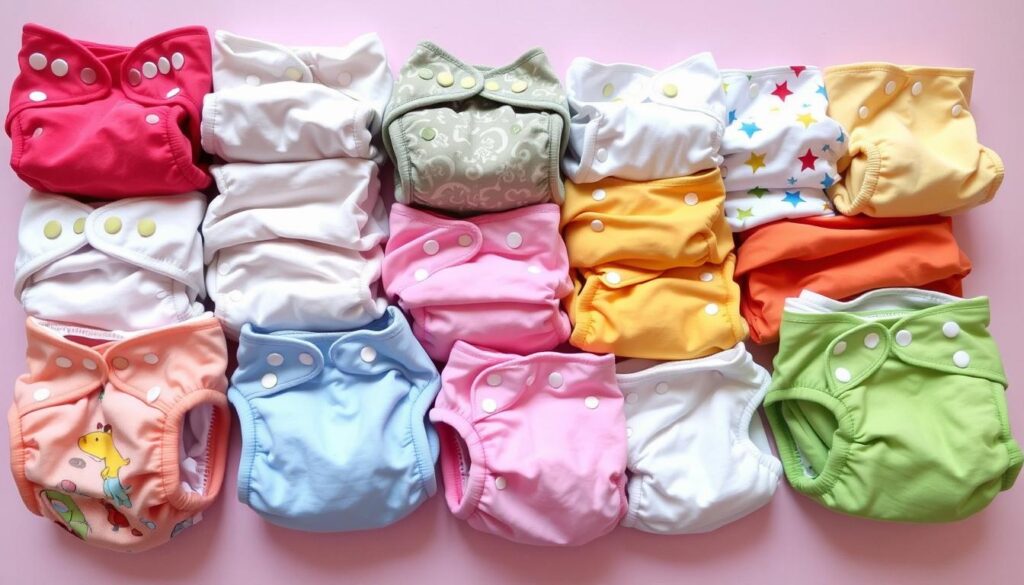
Finding the right mix of comfort, convenience, and eco-friendliness is key. With the right diapers and accessories, you can meet your baby’s needs. This ensures a clean, dry, and comfy space for them.
Clothing: Keeping Your Little One Cozy
Dressing your baby in comfy and right clothes is key for their happiness. Soft onesies and cozy pajamas are a must. They help keep your little one happy and warm.
The world of baby products is huge and can feel too much. Let’s look at the basic clothes every newborn needs:
- Onesies: These are a must, offering a snug fit and easy diaper changes.
- Pajamas: Soft and comfy, they keep your baby warm and cozy while sleeping.
- Outerwear: Jackets, sweaters, and hats protect your baby from the weather outside.
- Socks and booties: They keep tiny toes warm and stop heat loss.
Dressing your newborn in layers is smart for keeping them at the right temperature. Start with a onesie, then add a sweater or jacket as it gets colder. Always check the temperature and your baby’s comfort level.
| Clothing Item | Purpose | Quantity Needed |
|---|---|---|
| Onesies | Versatile all-in-one garment | 6-10 |
| Pajamas | Comfortable sleepwear | 4-6 |
| Outerwear (jackets, sweaters, hats) | Protection from the elements | 2-4 |
| Socks and booties | Keeping tiny toes warm | 6-10 |
Choosing the right clothing and dressing your baby in layers keeps them cozy and comfy all day and night.
https://www.youtube.com/watch?v=AeQmdxOhcko
“Dressing your baby in the right clothing is like wrapping them in a warm hug – it’s essential for their comfort and well-being.”
Baby Formula: Nourishing Your Newborn
As a new parent, you might wonder if to breastfeed or formula-feed your baby. Both ways have their benefits, and it’s a personal choice. But, your baby’s nutritional needs must be met, no matter what.
Breastfeeding vs. Formula Feeding
Breastfeeding is seen as the best for infant nutrition. It gives your baby nutrients and antibodies for growth. Yet, some parents choose formula feeding for various reasons. Formula-fed babies can also grow well and get the nutrients they need.
Choosing the Right Formula
There are many formulas available, each with different ingredients. The right one depends on your baby’s age, diet, and health. When picking a baby formula, consider:
- Protein source (cow’s milk, soy, or hypoallergenic)
- Carbohydrate composition (lactose, sucrose, or glucose)
- Supplemental nutrients (iron, vitamins, and minerals)
- Sensitivity to certain ingredients (for babies with allergies or intolerances)
Always talk to your pediatrician to find the best formula feeding for your baby. Their needs can be different.
“Feeding your baby is one of the most fundamental and rewarding experiences of parenthood. Whether you choose to breastfeed or formula feed, the most important thing is that your baby is receiving the nourishment they need to thrive.”
Toys: Stimulating Your Baby’s Development
Toys are key for your baby’s growth in thinking, moving, and feeling. Picking the right toys can really help your baby’s curiosity and well-being. There are many toys, like rattles and blocks, that help your child learn and explore.
Age-Appropriate Toy Selections
It’s important to choose toys that match your baby’s age and needs. Babies love toys that feel good, like soft things and sounds. As they get older, they might like toys that challenge them, like puzzles and blocks.
Make sure the toys you pick are safe and right for your child’s age. Always watch your baby when they play with new toys.
- Rattles and soft, colorful toys for newborns and infants
- Building blocks, puzzles, and shape sorters for toddlers
- Pretend play toys, such as play kitchens and dress-up clothes, for preschoolers
“Toys are children’s words and play is their language.” – Garry Landreth
Using a mix of toys that challenge different senses and skills is great for your baby. By watching what they like and need, you can help them grow and learn in a fun way.
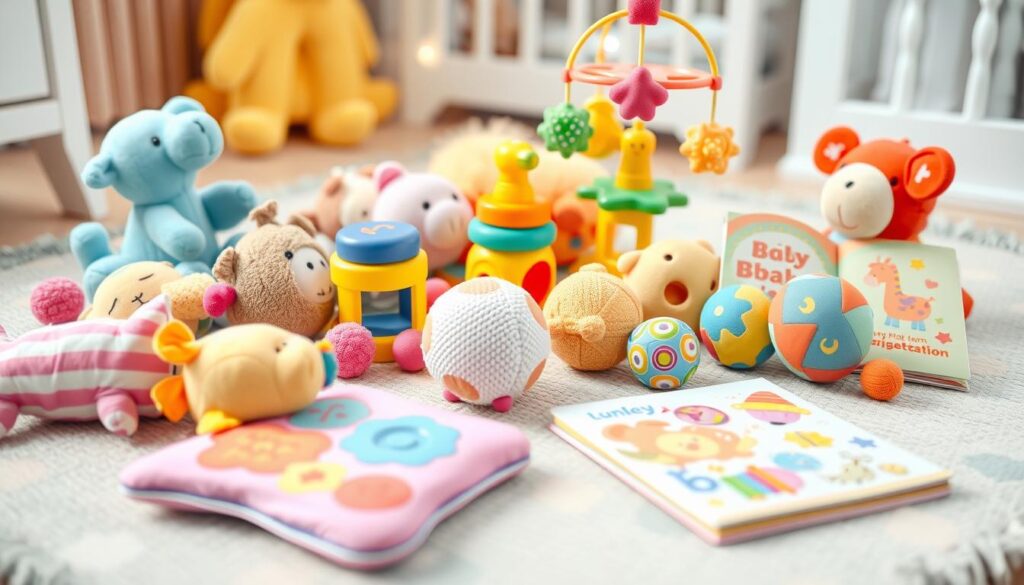
Cribs: Creating a Safe Sleeping Environment
Keeping your baby safe and comfortable while they sleep is very important. There are many cribs to choose from, each with its own style. Whether you prefer a classic wooden crib or a modern one that can change with your baby, there’s something for everyone.
Choosing the right crib is a big decision. Here are some important things to think about:
- Safety standards: Make sure the crib meets the latest safety rules from groups like the Consumer Product Safety Commission (CPSC).
- Size and dimensions: Pick a crib that fits well in your nursery. It should have enough room for your baby to move and grow.
- Adjustable mattress height: An adjustable mattress makes it easy and safe to put your baby in and take them out of the crib.
- Durability: Look for a crib made with strong materials. It should last for many years.
Along with the crib, the right bedding and sleep accessories are key. A comfy mattress, soft sheets, and a light blanket can help your baby sleep well.
Creating a safe and cozy sleeping area for your baby is vital for their growth and health. By picking the right crib and baby products, you can help your baby get the sleep they need to grow strong.
Strollers: Mobility for On-the-Go Parents
Strollers are a must-have for parents always on the move. They offer a comfy and easy way to carry your little ones. With so many choices, it’s key to find a stroller that meets your family’s needs.
Stroller Features to Consider
When picking a stroller, think about these important points:
- Maneuverability: Choose a stroller with smooth wheels and easy steering. This makes it simple to move through tight spots and crowded places.
- Adjustability: Opt for a stroller that grows with your child. Look for ones with adjustable seats and recline options for lasting use.
- Storage: A stroller with lots of storage is super handy. Whether it’s a big basket underneath or extra pockets, it makes outings and travel easier.
- Portability: Consider the stroller’s weight and how it folds. This ensures it’s easy to carry and store, especially when you’re on the go.
By focusing on these features, you can find the ideal stroller. It will keep your little one safe and comfy. Plus, it will give you the freedom and ease you need as a busy parent.
“A good stroller is a game-changer for on-the-go parents. It’s an essential investment in your family’s comfort and convenience.”
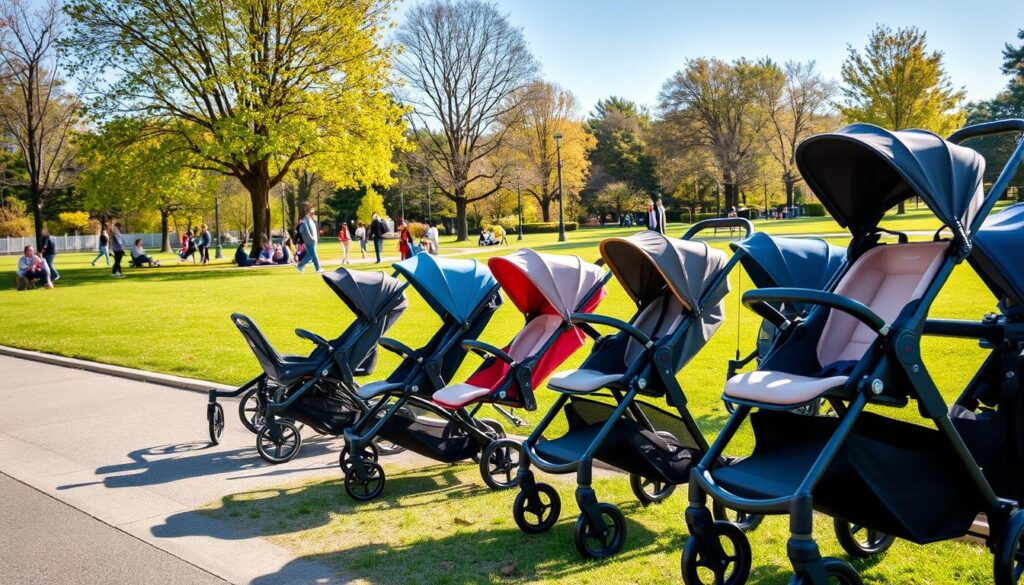
Car Seats: Ensuring Safe Travel
As a parent, keeping your child safe on the road is key. Car seats are vital for protecting your little one. It’s important to pick the right car seat and install it correctly.
Car Seat Installation and Safety Tips
Finding your way through car seats can seem tough. But with the right help, you can install and use them right. Here are some tips to help:
- Pick the right car seat for your child’s age, weight, and height. Rear-facing seats are best for babies and toddlers until they’re too big.
- Follow the car seat’s instructions for installation. This might mean using the seat belt or the LATCH system.
- Make sure the car seat fits snugly. It shouldn’t move more than an inch in any direction.
- Adjust the harness straps so they fit your child tightly. There should be no more than two fingers’ width between the straps and their chest.
- Never put a rear-facing car seat in the front seat of a car with an active airbag. Always use the back seat for these seats.
- Register your car seat with the maker to get updates on recalls or safety news.
By following these tips, you can feel sure your child is safe in the car. Choosing the right car seats and using them right is key to keeping your baby products safe.
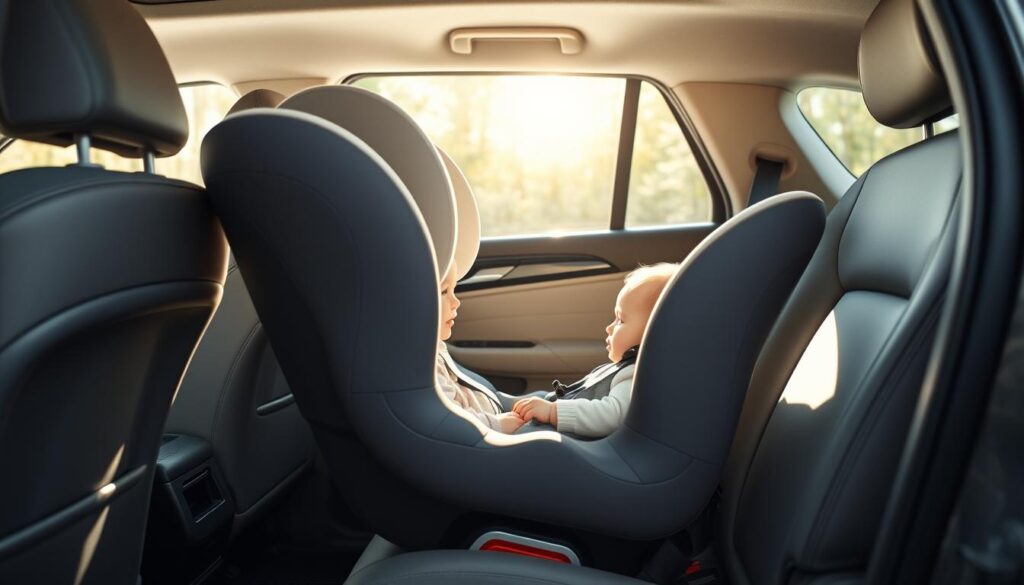
| Car Seat Type | Age/Weight Recommendation | Key Features |
|---|---|---|
| Rear-Facing Car Seat | Birth to at least age 2 or until they reach the maximum height and weight for the rear-facing seat | Provides the most protection for the head, neck, and spine in a crash |
| Forward-Facing Car Seat | Age 2 until they reach the maximum height and weight for the forward-facing seat | Harness system to secure the child and a tether strap to anchor the top of the seat |
| Booster Seat | Once they outgrow the forward-facing seat, typically around age 4 until the seat belt fits them properly | Lifts the child to position the seat belt correctly on their body |
Pacifiers: Soothing Your Little One
Pacifiers can be a great way to comfort your newborn baby. They can calm fussy infants, help with sleep, and ease the switch to bottle or breastfeeding. Knowing the good and bad of pacifiers helps you decide if they’re right for your baby.
The Benefits of Pacifiers
Pacifiers offer many benefits for babies and parents. They can:
- Provide comfort and soothe crying or fussiness
- Help babies self-soothe, which can improve sleep quality
- Reduce the risk of sudden infant death syndrome (SIDS)
- Ease the transition to bottle or breastfeeding
Choosing and Introducing Pacifiers
Choose a pacifier that’s designed for teeth health, with a shape like a mother’s breast. Look for ones made of silicone or latex, as they’re safer and last longer. Start with a small amount of time and follow the guidelines to keep your baby safe and comfortable.
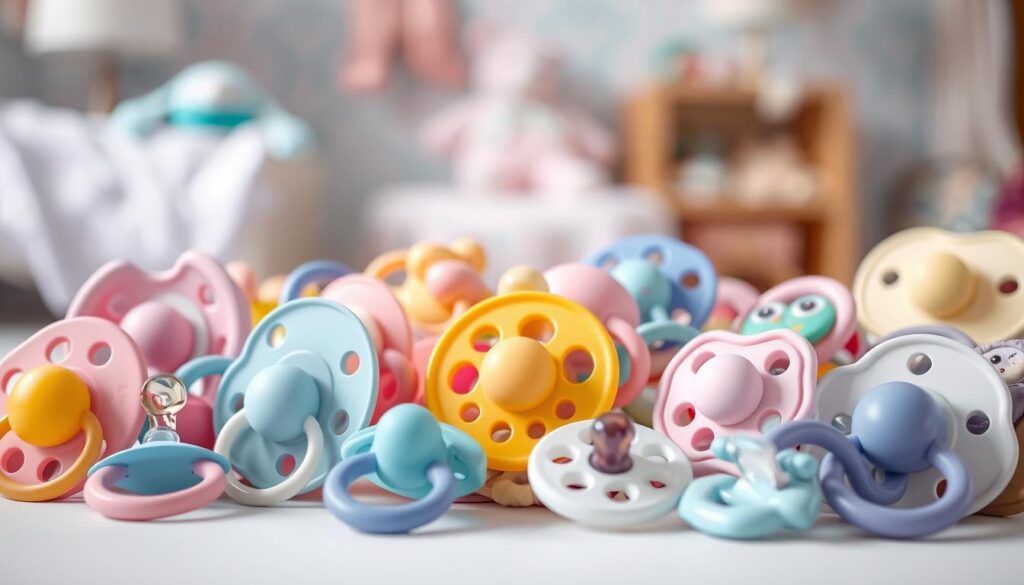
Every baby is different, and what works for one might not work for another. If your baby doesn’t like pacifiers, there are other ways to soothe them. Try rocking, singing, or using other baby products. The most important thing is to find what works best for your family.
Baby Products: Essential Items for Daily Care
There are many products that make daily care easier. These include items for bathing, feeding, and grooming. They help you enjoy the moments of caring for your baby.
Bath Time Necessities
Keeping your baby clean and comfortable in the bath is key. You’ll need a soft, slip-resistant bathtub, gentle shampoo and soap, a hooded towel, and a soft washcloth. A bath thermometer is also helpful for the right water temperature.
Feeding Essentials
Right feeding tools make mealtime easier, whether you’re breastfeeding or formula-feeding. You’ll need bottles, nipples, bibs, and a nursing pillow. A bottle warmer and a sturdy high chair are also good for later.
Grooming Necessities
- Soft-bristle baby hairbrush
- Gentle nail clippers or file
- Baby lotion and diaper rash cream
- Cotton swabs and soft washcloths
These grooming items keep your baby looking and feeling great. Always pick products made for baby skin and hair.
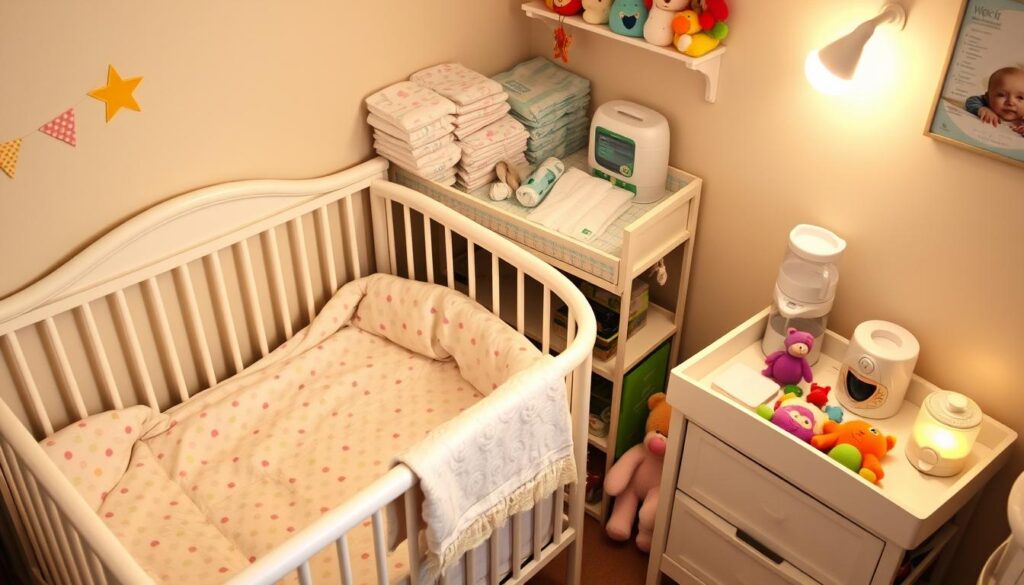
Having these baby products ready helps you care for your baby with ease. It ensures your baby’s comfort and well-being.
Budgeting for a Baby: Cost Considerations
Welcoming a new baby is exciting but comes with big financial responsibilities. You’ll need to think about many expenses, like diapers, clothes, healthcare, and childcare. A detailed baby budget helps manage your money and ensures your baby has everything needed.
One big expense is baby costs for diapers. Newborns use up to 12 diapers a day, which can cost hundreds monthly. Consider the type of diapers and how often you change them when budgeting.
- Disposable diapers cost $20 to $80 monthly, based on brand and size.
- Reusable cloth diapers cost more upfront but save money, around $15 to $40 monthly.
Baby clothes are another big expense. Babies grow fast and need new clothes often. Budget $50 to $100 monthly for clothes, including onesies, pants, socks, and jackets.
Healthcare costs, like doctor visits and shots, should be in your baby budget. These costs vary based on insurance and your baby’s health. It’s smart to save for unexpected medical bills.
“The key to managing the costs of raising a baby is to create a realistic budget and stick to it. By planning ahead and prioritizing your baby’s needs, you can ensure a smooth and financially secure start to parenthood.”
Remember, baby costs include more than just essentials. You’ll also need to budget for childcare, formula or breastfeeding supplies, toys, and developmental resources. By planning your baby budget carefully, you can face the financial challenges of having a baby with confidence and preparation.
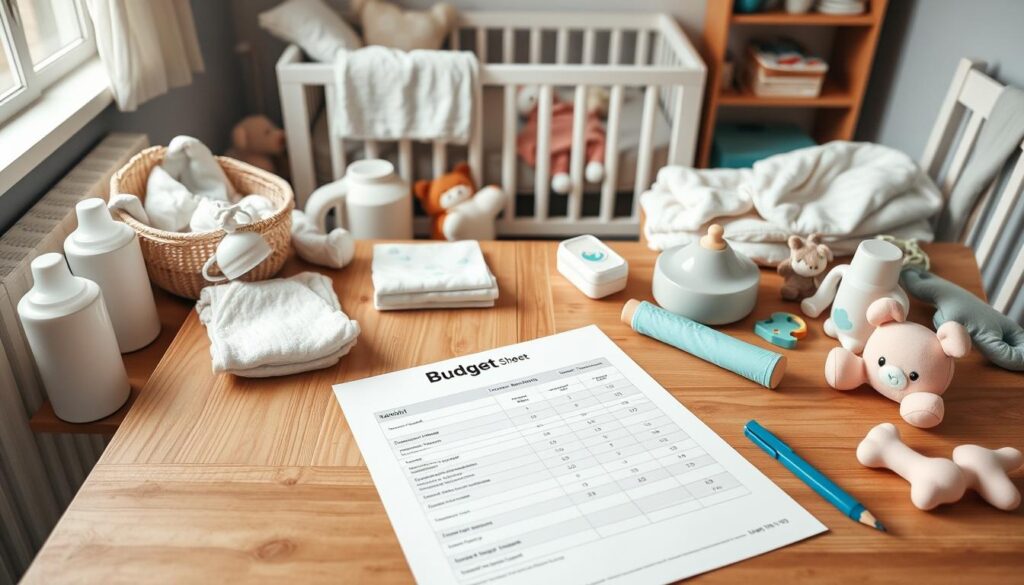
Conclusion
Caring for a newborn is both rewarding and challenging. This guide gives you the essential info to ensure your baby starts off healthy and happy. It covers everything from diapers and clothes to toys and safe sleep spots.
By focusing on the essentials for a baby, you can feel more confident in your parenting. Every baby is different, so be ready to adjust as you learn what works for your family. With the right prep and patience, you’ll give your baby a great start.
Starting this new chapter is exciting. We wish you all the best. With the info from this article, you’re ready to face the joys and challenges of parenting. Enjoy every moment with your baby.

